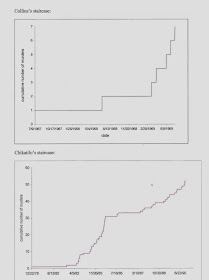 |
| Alice Elizabeth Kalom |
When Alice left her apartment in a house at 311 Thompson St, she was nicely dressed in a purple blouse, a white mini-skirt, pantyhose, and a pair of brown loafers. She was wearing her contact lenses and not her glasses. Alice was carrying her new pair of purple dress shoes she had recently purchased at Jacobson's in downtown Ann Arbor because she didn't want to get them wet. Alice was also wearing a distinctive, multicolored, horizontal striped rain coat against the likelihood of more rain.
Alice was last seen at the Depot House dancing until after midnight on Sunday morning. That's what some people at the party told police. Others said they thought she hadn't gone to the party at all. Alice's partially nude body was found in Ann Arbor Township off of US-23 and N. Territorial Rd in two feet of tall grass just off a lane running through abandoned farmland. Three teenaged boys came across her lifeless body on Monday, the 9th at 3:40 PM.
***
Forty-five years after the murder of his dear friend Alice, sixty-nine year old Benjamin R. Cologie became very emotional when he talked to my researcher Ryan M. Place about his memories of those times. Mr. Cologie is still angry with police because of their indecent and impolite behavior when they interrogated him over the murder of Alice Kalom. "It's terrible to say, but I wish I had never known Alice."
"I went to Alice's apartment on Saturday night. We were both taking a photography class at U of M, and she left prints floating in the rinse water with the images getting damaged. I hung the prints up and waited for her. At 11:00 AM on Sunday, I called the Ann Arbor Police to report Alice missing when she didn't come home all night.
"The following day, Monday, June 9th, the police found her murder site, the Washtenaw Sand and Gravel Company. They also found Alice's distinctive raincoat, some buttons torn from her clothing, some shoes (loafers only), and a pool of blood. When I learned that Alice's body had been found, I drove to the police station and they held me overnight telling me that I was their prime suspect in her murder.
"They took me to the morgue to identify her body before they even called her parents. They pulled out the slab. She had been outside for a couple of days, her eyes were wide open, her skin discolored, and a bullet wound was visible in her forehead. I identified Alice and all the cop said to the morgue tech was 'Go tag her' and walked off coldly. That vision of Alice dead on the morgue slab has haunted me for forty-five years. I still think about it frequently. It's something I will never forget.
"About a week later, my teaching friend Marisa invited me over to her farmhouse off Nixon Rd and Pontiac Trail. By this time, my name had made it around to the newspapers. I walk into my friend's house and her boyfriend attacks me! Thinks I came to rape her or murder her or something. It was terrible. I lost lots of friends over the Alice Kalom media mess, not to forget that I lost Alice.
"Two years later, I'm teaching at Pioneer High School and the cops bring bloodstained clothes and pictures of Alice for me to look at. The rudeness of the police asking overly personal questions about our sexual relationship. They wouldn't let me rest and forget.
Four police departments didn't seem to be sharing information. I had to repeat things hundreds of times. Police weren't helpful or compassionate. They just cared about who was going to get credit for solving the crime.
"Another thing I remember from those times were the many abandoned farms in the Ann Arbor area. For our class, Alice and I used to take pictures of timber framed barn shells, the barn siding mostly salvaged from them. We went to one abandoned farmhouse on Pontiac Trail.
 |
| Body Drop Site of Alice Kalom Near Abandoned Barn. |
"There was a cord hanging from the ceiling that looked like a noose. Alice put her neck through the noose-like cord and made me take a macabre photo of her standing inside this creepy farmhouse. I believe the cops still have that photo somewhere. Very scary incident in retrospect after what happened. The police confiscated all of the film and pictures from Alice's apartment."




